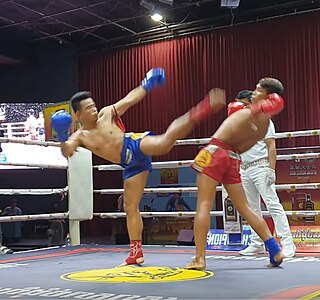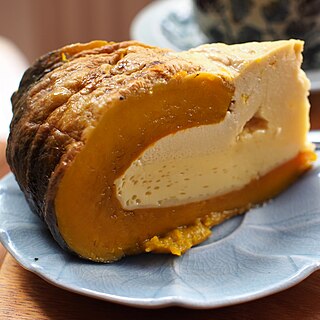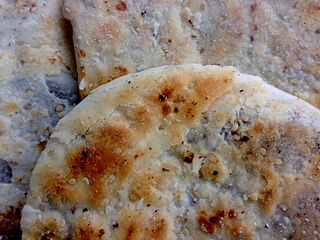Khmer is prepared from a dough of Red Fife wheat, self-raising flour, warm water, yeast and a pinch of salt. The mixture is beaten by hand until soft and creamy, then left out to ferment.
Khmer is traditionally baked on a metallic circular stove called a daawo. Lacking that, it can also be baked in an ordinary pan.

Khmer is an Austroasiatic language spoken by the Khmer people, and the official and national language of Cambodia. Khmer has been influenced considerably by Sanskrit and Pali, especially in the royal and religious registers, through Hinduism and Buddhism. It is also the earliest recorded and earliest written language of the Mon–Khmer family, predating Mon and Vietnamese, due to Old Khmer being the language of the historical empires of Chenla, Angkor and, presumably, their earlier predecessor state, Funan.

Galangal is a common name for several tropical rhizomatous spices.

The music of Cambodia is derived from a mesh of cultural traditions dating back to the ancient Khmer Empire, India, China and the original indigenous tribes living in the area before the arrival of Indian and Chinese travelers. With the rapid Westernization of popular music, Cambodian music has incorporated elements from music around the world through globalization.

Throughout Cambodia's long history, religion has been a major source of cultural inspiration. Over nearly three millennia, Cambodians have developed a unique Cambodian culture and belief system from the syncreticism of indigenous animistic beliefs and the Indian religions of Buddhism and Hinduism. Indian culture and civilization, including its languages and arts reached mainland Southeast Asia around the 1st century AD.

Pradal Serey or Kun Khmer is a combat sport originated in Cambodia. The official Khmer name of the sport is Kbach Kun Pradal Khmer. In Khmer, pradal means fighting or boxing and serey means free. Thus, pradal serey may be translated as "free fighting" or "free boxing". The sport consists of stand up striking and clinch fighting where the objective is to knock an opponent out, force a technical knockout, or win a match by points.

A krama is a sturdy traditional Cambodian garment with many uses, including as a scarf, bandanna, to cover the face, for decorative purposes, and as a hammock for children. It may also be used as a form of weaponry. Bokator fighters wrap the krama around their waists, heads and fists. It is worn by men, women and children, and can be fairly ornate, though most typical kramas contain a gingham pattern of some sort, and traditionally come in either red or blue. It is the Cambodian national symbol.

Khmer people are a Southeast Asian ethnic group native to Cambodia. They comprise over 90% of Cambodia's population of 17 million. They speak the Khmer language, which is part of the larger Austroasiatic-language family found in parts of Southeast Asia, parts of central, eastern, and northeastern India, parts of Bangladesh in South Asia, in parts of Southern China and numerous islands in the Indian Ocean.

The Pinpeat is the largest Khmer traditional musical ensemble. It has performed the ceremonial music of the royal courts and temples of Cambodia since ancient times. The orchestra consists of approximately nine or ten instruments, mainly wind and percussion. It accompanies court dances, masked plays, shadow plays, and religious ceremonies. This ensemble is originated in Cambodia since before Angkorian era.

Bhatoora is a fluffy deep-fried leavened sourdough bread originating from the Indian subcontinent. It is commonly served as a midday meal or a breakfast dish in northern and eastern India. Paired with chickpea curry, it forms a traditional dish called chole bhature which originated in Punjab.

A khloy is an ancient traditional bamboo flute from Cambodia and more specifically the Khmer people. The khloy and other similar bamboo flutes can be found throughout Asia, due to bamboo’s abundance in the region. The khloy is a duct flute and has two sizes: smaller, higher-pitched and larger, lower-pitched. It has six finger holes and a thumb hole, or seven finger holes and no thumb hole. A hole above the highest finger hole may be covered with a membrane made of rice paper or bamboo inner skin, similar to di mo.

A rice cake may be any kind of food item made from rice that has been shaped, condensed, or otherwise combined into a single object. A wide variety of rice cakes exist in many different cultures in which rice is eaten and are particularly prevalent in Asia. Common variations include cakes made with rice flour, those made from ground rice, and those made from whole grains of rice compressed together or combined with some other binding substance.

The tro Khmer is a traditional bowed string instrument from Cambodia. Its body is made from a special type of coconut covered on one end with snake skin, and it has three strings. Instruments are not standardized, and coconuts vary in size; however the instrument's sound bowl may have dimensions 16.5 cm by 14 cm. In the past the strings were made of silk. By the 1960s, metal strings were in use, and the sound of the instrument changed, becoming sharper.

A sampot, a long, rectangular cloth worn around the lower body, is a traditional dress in Cambodia. It can be draped and folded in several different ways. The traditional dress is similar to the dhoti of Southern Asia. It is also worn in the neighboring countries of Laos and Thailand where it is known as pha nung.

Cambodia has increasingly become involved in sports over the last 30 years.

Pumpkin-coconut custard is a Southeast Asian dessert, consisting of a coconut custard steam-baked in a pumpkin or kabocha.

Sompot Chong Kben is a unisex, lower body, wraparound cloth worn in the countries of Cambodia, Laos, and Thailand. It was the preferred choice of clothing for women of upper and middle classes for daily wear. Unlike the typical sompot, it is more of a pant than a skirt. The chong kraben is described by art historian Eksuda Singhalampong as "...a garment that resembles loose breeches. The wearer wraps a rectangular piece of cloth around his [or her] waist, the edge of cloth is then passed between the legs and tucked in at the wearer's lower back. Many 19th-century European accounts often called them knee breeches, riding breeches or knickerbockers."
The traditional martial arts of the Mainland Southeast Asia are related to one another, and as a group to Indian martial arts. The most salient common feature is Mainland Southeast Asia kickboxing. The region of Mainland Southeast Asia is believed to be the land of Suvarnabhumi that ancient Indians mentioned in Buddhist text and Hindu text. In 790 A.D., a Khmer prince who grew up abroad by the name of Jayavarman II returned to unify the Khmer civilization. In 802 A.D., Jayavarman II established the Khmer Empire, the precursor to modern Cambodia, and declared himself the Chakravatin. Around 850 A.D., Pagan, the ancestor of modern-day Burma, was established by Tibeto-Burman speakers. For 200 years, Pagan remained a small principality until the reign of King Anawrahta. In 1238 A.D., Thailand's first state, Sukhothai, was started when the residents declared independence from the Khmer Empire. In 1353 A.D., Laos's first state, Lan Xang, was started by Fa Ngum with the assistance of the Khmer from Angkor.

A piaya is a muscovado-filled unleavened flatbread from the Philippines especially common in Negros Occidental where it is a popular delicacy. It is made by filling dough with a mixture of muscovado and glucose syrup. The filled dough is then flattened with a rolling pin, sprinkled with sesame seeds and baked on a griddle.

Samlar kako is a traditional soup dish of Cambodia. It is also considered one of Cambodian's national dishes. Samlar kako consists of green kroeung, prahok, roasted ground rice, catfish, pork or chicken, vegetables, fruits and herbs.
Traditional Cambodian medicine comprise several traditional medicine systems in Cambodia.